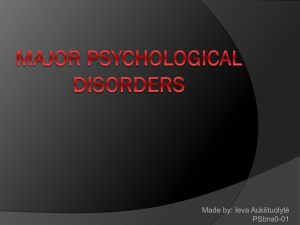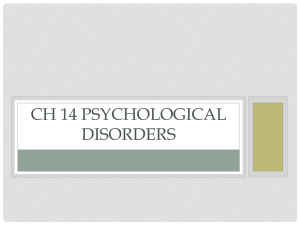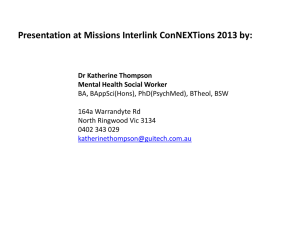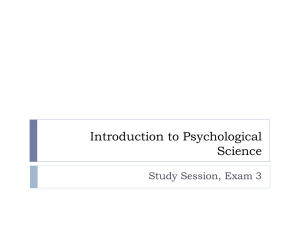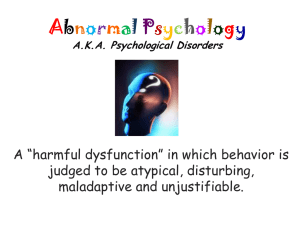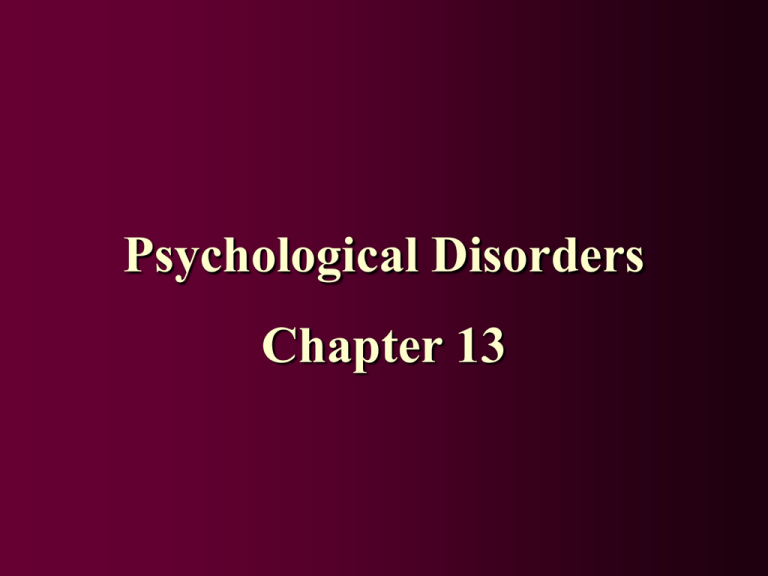
Psychological Disorders
Chapter 13
What is Abnormal?
• Abnormal - literally meanss “away from the
normal” so Einstein was “abnormal.”
• Society: Abnormal behavior must be
defined within the context of the society.
• A practial definition: Behavior is abnormal
when it causes the individual or those
around him discomfort, distress, or danger.
A Brief History
• Primitive peoples - saw aabnormal
behavior as a sign that the person was
possessed by demons or spirits
• Golden age of Greece - Hippocrates and
others viewed mental illness as a
“natural” phenomenon like other illness
• Middle ages - a return to belief in
possession and demonology. Knowledge
was kept alive in the Islamic countries.
• Phillipe Pinel - In 1793 was made head of La
Bicetre hospital in Paris and began a trend
toward humane treatment
• Dorothea Dix - In the U. S. during the 1800s
fought for the rights of the mentally ill
• A medical discovery - by 1900 it was
discovered that “general paresis” (which
included severe mental deterioration) was
caused by syphilis (a physical disease). This
gave rise to the “biological model” of mental
illness
Approaches to Psychological Disorders
1 biological model: Disorders have a
biochemical or physiological basis.
2 psychoanalytic model: Disorders
result from unconscious internal
conflicts.
3 cognitive-behavioral model: Disorders
result from learning maladaptive ways
of thinking and behaving.
Approaches to Psychological
Disorders
4 diathesis-stress model: A “diathesis” is
a genetic or other biological
predisposition or vulnerability. Under
stress, a person may develop a disorder
to which he/she is predisposed.
4 systems approach: Biological,
psychological, and social risk factors
combine to produce disorders. Also
known as the “Biopsychosocial” model
Classifying Psychological Disorders
• Diagnostic & Statistic Manual of Mental
Disorders (4th edition) “DSM IV” Published
by the American Psychiatric Association
• It is the most widely used classification system
of psychological disorders.
• It is a listing of disorders, their symptoms, and
statistical data (e.g., gender, age, differences)
• It does NOT specify treatments and does NOT
list causes of disorders
Prevalence and Incidence
• Prevalence - refers to how common a
disorder is. For example, schizophrenia
is rare (1% of the population) while
depression is more common at about 34%
• Incidence - refers to the rate at which
new cases occur. If the yearly incidence
rate for depression is 1%, then there
would be one new case for every hundred
people in the population this year.
Basic Diagnostic Categories of DSM-IV
Basic Diagnostic Categories of DSM-IV
Mood Disorders (affective disorders)
• Disorders in which one’s range of
affect (mood) is restricted (as in
depression) or expanded (as in bipolar
disorder).
•
•
•
•
Major Depression
Dysthymia
Bipolar Disorder (formerly manic depression)
Cyclothymia
Depression
• more than just a case of “the blues”
• overwhelming feelings of sadness
• lack of interest in activities and inability to
experience pleasure
• excessive guilt or feelings of worthlessness
• changes in sleep, appetite, ability to
concentrate
• possible suicidal thoughts or actions
Major Depression
• very severe
• symptoms must be present for two weeks
• person may be unable to function normally
and may need hospitalization
Dysthymia
• less severe but “chronic”or long lasting
• symptoms must be present for two years
• person can usually function but leads a very
unhappy, painful, unfulfilling existence
Bipolar Disorder
• Person experiences alternating episodes of
depression and mania “mood swings”
• a manic state involves excess energy, racing
thoughts, pressured speech, grandiosity,
impulsive behavior, poor judgement
Cyclothymia
• a less severe form of bipolar disorder
Causes of Mood Disorders
• biological factors
– genetics - mood disorders are more common in
close relatives, esp. bipolar disorder
– brain chemistry changes as a result of
experience (e.g., stress or illness)
• psychological (cognitive) factors
– cognitive distortions such as (1) all or none
thinking (2) inaccurate maladaptive beliefs
• social factors/stressors
– real or perceived loss or stress in various areas
Suicide
• myth - people who talk about it never do it
• fact - most people will give clues about their
plans
• fact - more women attempt but more men
complete, men use more lethal methods
• fact - people thinking of suicide will often give
away possessions and “put their affairs in order”
• fact - suicide is becoming more common among
teens and children
Gender, Race, & Suicide
Anxiety Disorders
Disorders in which anxiety is a characteristic
feature OR the avoidance of anxiety seems
to motivate abnormal behavior.
• phobias
• panic disorder
• generalized anxiety disorder
• obsessive-compulsive disorder
Phobic Disorders
• phobia: (from the Greek “phobos”) which
means fear
• The person feels intense fear when
confronted with the phobic object or
situation. This may lead to a “panic
attack.”
• The phobic person avoids the phobic
object or situation. Some may endure it
but with great anxiety and discomfort.
Types of Phobias
• specific phobia: fear of a particular object or
situation, common examples
– insects, animals, blood/injury, heights,
enclosed spaces, thunder, water, germs
• social phobia: excessive, inappropriate fears
connected with social situations or
performances in front of other people
• agoraphobia: fear of multiple situations, is
almost always a consequence of “panic
disorder”
Panic Disorder
• panic attack: is a sudden, unpredictable,
and overwhelming experience of intense
fear or terror without reasonable cause.
• Hallmark symptoms: fear of dying, losing
control, or going crazy, depersonalization,
and derealization (things seeming weird)
• other symptoms: chest pain, increased
heartbeat, dizziness, choking sensations,
intense headache, tingling in arms or legs,
terror of being left alone
• agoraphobia: fear and avoidance of places
(1) in which help would not be available if
needed and (2) from which escape would be
difficult or embarassing
• typical situations: public transportation,
large stores/malls, interstates, bridges,
elevators, wilderness, theatres, sports
arenas, concerts,
• panic disorder with agoraphobia: often,
especially in women, panic attacks lead to
fear and avoidance of places/situations in
which panic attacks occurred
Generalized Anxiety Disorder
• anxiety disorder characterized by prolonged
vague fears that are not attached to any
particular object or circumstance
• “chronic”: long term, almost a part of the
person’s personality
• symptoms: sleep problems, muscle aches,
digestive problems, headaches, inability to
relax, constant worry, difficulty in
concentration, headaches, etc.
Obsessive-Compulsive Disorder (OCD)
• The person is plagued by “obsessions”
and/or “compulsions”
• obsessions: unwanted intrusive thoughts,
obsessions often involve fear of making
mistakes which might cause harm.
Contamination and guilt are also common
themes
• compulsions: behaviors/rituals that reduce
anxiety caused by obsessions, classic
compulsions are checking, and washing
Posttraumatic Stress Disorder
(PTSD)
• Results from a “traumatic” event that is
“outside the normal range of human
experience”
• Typical experiences are military
combat, police action, natural disaster,
accidents, and being a crime victim.
Symptoms of PTSD
• re-experiencing of the trauma through
– intrusive thoughts, dreams, and “flashbacks”
• avoidance of “trauma-related” stimuli
– the person is made anxious by, and avoids,
reminders of the trauma
• exaggerated startle and hypervigilence
• other symptoms and associated problems:
– tension, sleep problems, depression, social
withdrawal, explosiveness, suspiciousness of
others, substance abuse
Causes of Anxiety Disorders
• heredity: anxiety disorders do tend to run in
families (esp. OCD)
• stress: triggers anxiety in predisposed
people, the primary cause of PTSD
• learning: fears can be acquired via
classical/operant conditioning or modeling
• “biological preparedness hypothesis”
(Martin Seligman) We are prepared to
become phobic of certain things as a result
of our evolutionary history
Psychosomatic Disorder
(Psychophysiological Disorder)
• Disorders in which there is REAL
physical illness that is largely caused
by psychological factors such as stress
and anxiety.
• Examples are hypertension, headaches,
bruxism (teeth grinding), insomnia,
ulcers, digestive problems, etc.
Somatoform Disorders
There is an APPARENT physical illness
for which no organic (physical) basis
can be found
•
•
•
•
somatization disorder
conversion disorder
hypochondriasis
body dysmorphic disorder
Somatization Disorder
• A somatoform disorder characterized by
recurrent vague physical complaints with
no apparent physical cause
• Typical are bachaches, headaches,
dizziness, stomach pains, chest pains
• It is important to distinguish this from
“malingering” or faking in which the
person is “acting” sick to gain something
Conversion Disorder
• complaints of a dramatic specific disability
with no apparent physical cause (e.g.,
paralysis, blindness, deafness)
Classic Conversion Phenomena
• glove anasthesia: paralysis or numbness of
the hand that does not conform to anatomy
• la belle indifference: “beautiful indifference”
the person’s level of concern not consistent
with the severity of the ailment
Hypochondriasis
• The person interprets insignificant
symptoms as signs of serious illness
• A series of headaches might convince the
person he/she has a brain tumor
• Again, there is no organic evidence of
such illness.
• Patients may “doctor shop” searching for
one who will confirm their suspicions
Body Dysmorphic Disorder
• a recent phenomenon found in
developed western cultures
• the person becomes preoccupied with
his or her imagined ugliness, usually of
a particular body part
• plastic surgery is often sought
• probably has a lot to do with society’s
obsession with beauty and appearance
Causes of Somatoform Disorders
• Causes are less well understood than
for depression or anxiety
• Often “secondary gain” is a major
cause
• By being sick, the person may
unconsciously avoid work, child care,
or other responsibilities
Dissociative Disorders
Disorders in which some part of the
personality seems separated from the
rest. These are relatively rare.
• dissociative amnesia
• dissociative fugue
• dissociative identity disorder
• depersonalization disorder
Dissociative Amnesia
• There is a loss of memory for past
events (days, weeks, or years) without
organic cause.
• Dissociative amnesia may result from
an intolerable or painful experience
such as physical or sexual abuse.
Dissociative Fugue
• “fugue”: literally means to take flight
• a person suddenly leaves home and
assumes a new identity, with amnesia
for past identity and events.
• The person may emerge from the fugue
weeks or months later in a strange city
not knowing how he/she got there
Dissociative Identity Disorder
• formerly called “multiple personality
disorder” (MPD) or “split personality”
• a person has several distinct personalities
that emerge at different times.
• a history of physical or sexual abuse in
childhood is common
• borderline personality and eating disorders
often co-occur
• this is NOT the same as schizophrenia
Depersonalization Disorder
• A dissociative disorder whose main feature is
that the person suddenly feels strange or
different.
• Some describe it as an “out of body”
experience.
• Because depersonalization is also a symptom
of panic disorder (which is much more
common), that disorder should be ruled out
before making this diagnosis.
Causes of Dissociative Disorders
• The most widely accepted cause is that
the person has experiences one or more
traumatic experiences that they cannot
bear to think about.
• By separating the personality into
“parts,” the traumatic memories can be
avoided.
• General psychological instability may
also be a factor
Sexual Disorders
DSM-IV classifies sexual disorders
under two major divisions:
• sexual dysfunctions: loss or
impairment in some aspect of the
normal human sexual response
• paraphilias: Sexual disorders in which
unconventional objects or situations
become the focus of sexual interest
Sexual Dysfunctions
Some sexual dysfunctions are physical but
most have a psychological basis
• erectile disorder: The inability of a
man to achieve or maintain an erection.
• female sexual arousal disorder: The
inability of a woman to become
sexually aroused.
Sexual Dysfunctions
• sexual desire disorders: Disorders in
which the person lacks sexual interest
or has an active distaste for sex.
• sexual arousal disorder: Inability to
achieve or sustain arousal until the end
of intercourse in a person who is
capable of experiencing sexual desire.
Sexual Dysfunctions
• orgasmic disorders: Inability to reach
orgasm in a person able to experience
sexual desire and maintain arousal.
• premature ejaculation: In ability of a
man to inhibit orgasm as long as desired.
• vaginismus: Involuntary muscle spasms
in the outer part of the vagina that make
intercourse impossible.
Paraphilias
Paraphillias are primarily a “male”
phenomenon. Classical and operant
“conditioning” likely play a role.
• fetishism: A paraphilia in which a
nonhuman object is the preferred or
exclusive method of achieving sexual
excitement.
• voyeurism: Desire to watch others
having sexual relations or to spy on
nude people.
• exhibitionism: Compulsion to expose
one’s genitals in public to achieve
sexual arousal.
• frotteurism: Compulsion to achieve
sexual arousal by touching or rubbing
against a non-consenting person in
public situations.
• transvestic fetishism: Wearing the
clothes of the opposite sex to achieve
sexual gratification. (don’t confuse with
trans-sexualism)
• sexual sadism: Obtaining sexual
gratification from humiliating or
inflicting physical pain on a sex partner.
• sexual masochism: Obtaining sexual
gratification from being humiliated or
receiveing physical pain from a sex
partner.
• pedophilia: “pre-pubescent” children are
the focus of sexual fantasy or actual sexual
activity
• While this remains a “fantasy” it is a
psychological disorder. When the person
acts on the desire, it also becomes a
criminal activity.
• most pedophiles have great difficulty
fighting their desires
Gender-Identity Disorder
• a strong belief that one is really a
member of the opposite biological sex
(i.e., a woman trapped in a man’s body).
• many seek an operation to change their
gender which is granted only after
extensive counseling therapy (most are
happy with the change)
• These individuals are NOT transvestites
nor are they homosexuals
Personality Disorders
• Disorders in which inflexible and
maladaptive ways of thinking and
behaving learned early in life cause
distress to the person and/or conflicts
with others.
• As you might expect a person’s basic
way of relating to the world is very
difficult to modify
DSM-IV divides Personality
Disorders into 3 “Clusters” (groups)
• Cluster A: odd - eccentric
– schizoid, paranoid, schizotypal
• Cluster B: erratic - dramatic
– narcisstic, histrionic, borderline, antisocial
• Cluster C: anxious - fearful
– dependent, avoidant, obsessive-compulsive
Cluster A Disorders
Schizoid Personality Disorder
• The person is withdrawn and lacks
feelings for others.
• The person seems to have no need
or desire for close relationships
• odd behavior may also be present
(a loner or hermit)
Paranoid Personality Disorder
• The person is inappropriately
suspicious and mistrustful of others.
• The person may think friends or coworkers are plotting against him and
may doubt the loyalty of his spouse
• Paranoid personality disorder is NOT
the same as paranoid schizophrenia.
Schizotypal Persnoality Disorder
• literally means “schizophrenic
genotype,” there may be a genetic link
with schizophrenia,
• unusual belief systems are
characteristic of this disorder
– magical thinking, special powers, delusions
• the person may also have unusual
appearance and behavior
Cluster B Disorders
Narcissistic Personality Disorder
• The person has an exaggerated sense of
self-importance and demands constant
attention and admiration
• The person is “grandious” believing
he/she is “special” and very important
• They feel that only other “special” people
can understand them
Histrionic Personailty Disorder
• the person’s behavior and speech are
exaggerated and overly dramatic
• like the narcissist, they crave attention
but more out of need than grandiousity
• may be sexually promiscuous with
stormy relationships
• relationships with others are shallow
and superficial
Borderline Personality Disorder
• The most severe of the personality disorders
• characterized by marked instability in selfimage, mood, and interpersonal relationships
• a classic symptom is “cutting” oneself and
other self-mutilating behaviors
• other symptoms are depression, anxiety/panic
depersonalization, and drug use
• often co-occurs with MPD and like MPD a
history of childhood abuse is common
Antisocial Personality Disorder
• involves a pattern of violent, criminal, or
unethical and exploitative behavior and
an inability to feel affection for others
• the vast majority are males
• sly, cunning, charming, irresponsible,
shallow and unemotional, feel no
remorse
• substance abuse is common. These
behaviors are very difficult to change
Cluster C Disorders
Dependent Personality Disorder
• Personality disorder in which the
person is unable to make choices and
decisions independently and cannot
tolerate being alone.
• Appear to have an underlying fear of
being abandoned or rejected.
Avoidant Personality Disorder
• Personality disorder in which the
person’s fears of rejection by others leads
to social isolation.
• Avoidant personality disorder differs
from schizoid personality disorder in that
avoidant individuals want to have close
relationships with other people.
• Some believe this disorder is really the
same thing as social phobia
Obsessive-Compulsive Personality Disorder
• rigid, inflexible, overly moralistic,
unable to “have fun” and relax
• perfectionistic and cannot delegate
responsibility to others
• may get so caught up in details that the
main task is never completed
• may be an asset in some types of work
Schizophrenic Disorders
• Severe disorders in which there are
disturbances of thoughts,
communication, and emotions.
• positive symptoms: presence of some
behavior not seen in normal persons
(e.g., hallucinations, delusions)
• negative symptons: absence of behaviors
seen in normal persons (e.g., lack of
normal range of mood, normal hygiene)
Hallmark Symptoms
• delusions: false beliefs about reality that
have no basis in fact. Common delusions
involve thought broadcasting, thought
insertion, religious or supernatural topics
(vary with historical era and society)
• hallucinations: Sensory experiences in the
absence of external stimulation, most often
auditory. Voices may be heard talking
about the person or to the person, telling
him/her to do things
additional symptoms
• loosening of associations or tangential
thinking
• clanging (rhyming words with no
meaning)
• flat or blunted affect (no change in mood)
• social withdrawal/isolation
• lack of normal hygiene
• unpredictability
Types of Schizophrenic Disorders
• disorganized schizophrenia: bizarre and
childlike behaviors, giggling, odd faces,
gesturing
• paraniod schizophrenia: disorder is less
obvious, suspiciousness and complex
delusisonal systems are common
• catatonic schizophrenia: motor activity
disturbance is prominent.
• undifferentiated schizophrenia: those who
don’t really fit into one of the above
Causes of Schizophrenia
• twin studies suggest vulnerability is quite
heritable
• schizophrenics have high amounts of the
neurotranasmitter dopamine
• enlarged “ventricles” are seen in brains
• abnormal patterns of brain activiy have
been observed
• disturbed family relations are common
Childhood Disorders
• Attention-deficit/hyperactivity
disorder (ADHD)
• Autistic disorder
Attention-Deficit/Hyperactivity
Disorder
• A childhood disorder characterized by
inattention, impulsiveness, and
hyperactivity.
• Much more common in boys than girls.
• Diagnosis has been increasingly common
in recent years
• Commonly treated with psychostimulants
(e.g., ritalin)
Autistic Disorder
• literally: “turned inward”
• occurrence: autism is a very rare
disorder
• typical symptoms: lack of social
interaction, strange motor behaviors,
self destructive behaviors, fascination
with movement, attachment to odd
objects, intolerance of change
• echolalia: repeating words said to
them.
• “savant”: an autistic with special
abilities in some area (e.g., numbers,
art) most autistics are NOT “savants”
• causes: not known but genetics/biology
are strongly implicated
• there is some connection with mental
retardation and fragile x syndrome


